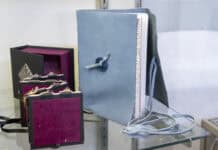The Sedona-Oak Creek Airport Authority broke ground on its new fuel farm storage site before its last board meeting on Feb. 28.
“This project is of critical importance to the airport from a fuel storage point of view, in supporting the activities of the airport’s operations, including search and rescue, fire protection for the area, including law enforcement, transport, movements of blood and human organs,” General Manager of the Sedona Airport Ed Rose said.
Currently, the airport has two 10,000-gallon above ground tanks, one for AvGas and one for Jet A fuel. The AvGas is used for smaller, piston-engine aircrafts, while Jet A is for larger, turbine jet engines. In the 2017 Airport Master Plan, which determines the direction of the airport until 2033, the need for a new fuel farm was already being discussed.
“Additional fuel storage capacity and upgrades should be planned when the airport is unable to maintain an adequate supply and reserve,” the report stated.
It went on to highlight discussions for additional Jet A fuel storage tanks, a fuel spillage containment system, a look into new potential locations and self-service stations for convenience.
“Everything revolves around the ability to have an adequate supply of fuel, and we have an aging system that’s 34 years old that’s no longer compliant, and we want to make sure that everything on this facility is as compliant as possible,” Rose said.
According to that 2017 study, 9,267 gallons of Jet A Fuel and 5,213 gallons of AvGas are used over a 14-day period. But as use increases, the airport predicted that those numbers would rise to 6,463 of AvGas usage and 11,492 of Jet A Fuel over the 14- day period.
Based on these studies showing Jet A fuel storage being inadequate, the new fuel farm will add another 10,000-gallon Jet A fuel tank.
The initial plan outlined at the additional fuel storage capacity should be planned in 10,000 to 12,000-gallon increments, similar to the current tanks, according to Dibble, the Phoenix-based engineering firm who will be overseeing the project at the airport.
“It was a self-funded project by SOCA, and they selected Dibble to be the contracting company,” said Carmen Rose, of Dibble Engineering.
The original budget sat around $2.7 million. But as supply chain issues escalated, along with inflation, the project is now estimated to cost the airport just over $4 million. But Rose and Sedona Airport Board President Pam Fazzini expressed how important this project is to maintaining the airport’s standards and fuel business.
Fazzini also said that the board greatly appreciates the partnership with National Bank of Arizona, as the project continues.
Official construction will begin sometime around Friday, April 1, with an estimated completion date by the end of 2022.
